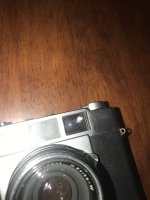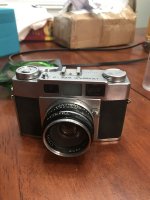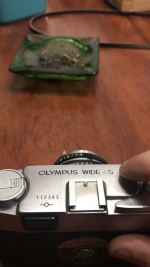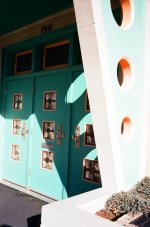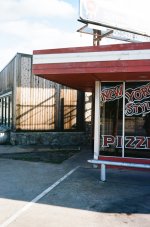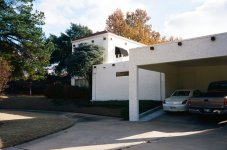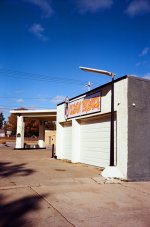Top plate appears to be in fantastic shape
Assuming, as has been suggested, the glass should be affixed to the cover itself with a mounting frame, to get back to your original query, yes, epoxy will be fine for this. Not much is needed, obviously, but it is a safe and long lasting choice of adhesive, unlike, for example, cyanoacrylate (super glue) which may do a very satisfactory job of actually securing internal parts, but can also be catastrophic to any interior glass surfaces due to its proclivity to outgas and deposit residues. Gluing the glass or its frame to the cover with epoxy will not be problematic. On removal of the cover, obviously, the air to glass surfaces will be accessible.
I suspect Sam may be able to inform whether the Wide S uses a composite prism (Ie similar to Leica M with two glass pieces cemented together to form a prism, one cemented surface being coated to reflect a rangefinder image) or a simple sheet of optical glass at a 45 degree angle with coated rear surface (as used in the screw mount Leica rangefinders and many other types of rangefinder). I've had a very quick search on Google and couldn't establish which is fitted.
You probably know this, but if a prism is fitted the microns thin reflective coating is protected from atmospheric or other contaminants by virtue of being inside the cemented joint of the two prism pieces. It's therefore safe to gently wipe clean both the front surface of the prism (Ie "lens" side) as well as the rear surface (eyepiece, or "film" side) with lens cleaner and/or isopropyl (although don't use too much, you don't want to wet the cemented joint and potentially encourage splitting).
On the other hand, if a sheet of beam splitter glass is used to reflect the focus patch (and I'd hazard a guess this is more likely than a prism, based on other early rangefinder Olympus models I have worked on) then, the lens side of the beam splitter may be gently wiped with impunity: it is merely optical grade glass which, whilst it
might be coated, ought to be able to withstand limited gentle wiping with fluid and lens tissue.
The eyepiece side of the beam splitter on the other hand, is where the ultra thin layer of reflective coating has been applied, and unlike a prism this coating is unprotected and vulnerable to damage from mechanical cleaning. Best not to touch it. It's certainly true that some makers' reflective coatings are better able to withstand one or two cleaning wipes without degradation than others. But, unless one is absolutely certain no damage may result, it really is better not to directly touch the surface at all. In the worst case scenario, a single very gentle wipe with the softest cloth or tissue, (even moistened with inert demineralised water) might see the coating completely removed. Along with any semblance of a usable rangefinder image!
Personally I prefer to take a clean cotton tip, immerse it in alcohol or lens cleaner, and dab it on the top edge of the glass as required so the fluid dribbles down across the coating. Ie you are "washing" the coating but not actually touching it. This will usually obtain a decent improvement in brightness and patch contrast without harming the coating. You may cut and fold a small piece of lens tissue, which may be held at the bottom of the housing, in order to absorb the fluid flowing across the coating so that it is not distributed to other parts of the camera. Obviously, you are using small amounts of fluid in the first place, but if one is to obtain some improvement in cleanliness, inevitably, there will be a small amount of run off. By angling the camera appropriately, and absorbing the cleaning fluid, it is usually possible to brighten the finder and improve the patch without creating other complications in the process.
This is general advice obviously, the actual design and interior accessibility of various types of rangefinder units can differ greatly. In some instances, safely cleaning a beam splitter in situ will be a breeze, in others, removal of the rangefinder unit from the camera and partial disassembly may well be needed to do a thorough cleaning job. In the case of your Olympus, if the patch calibration is still factory accurate you might be tempted to clean the optics in situ if possible. On the other hand if the patch is obviously out at infinity and will need to be calibrated, you might well elect to take the unit off for cleaning. See how you go. (I'm always interested to see some internal images of a rangefinder I've not yet worked on, so feel free to share a few images with the cover off if you're inclined).
Cheers
Brett


